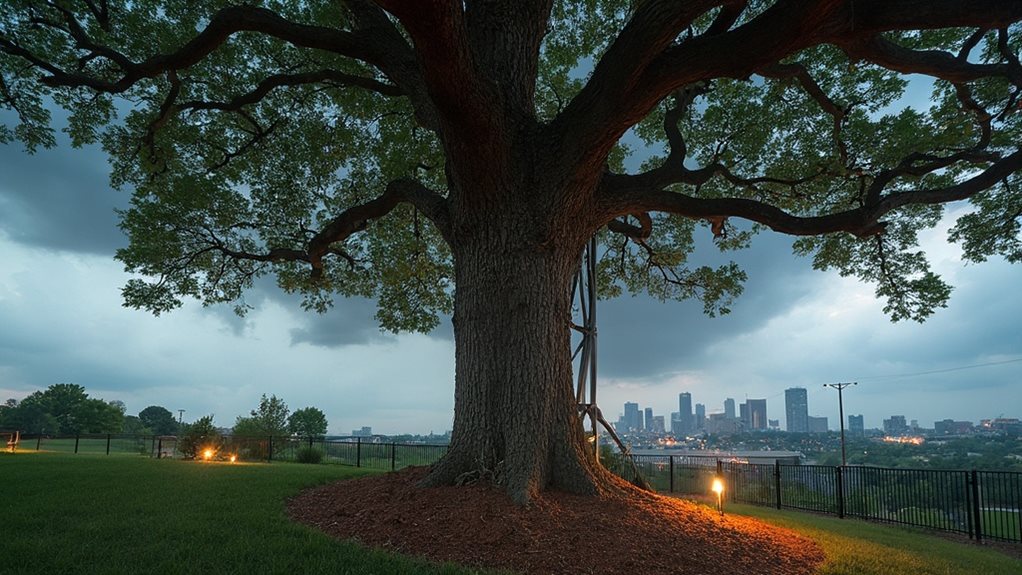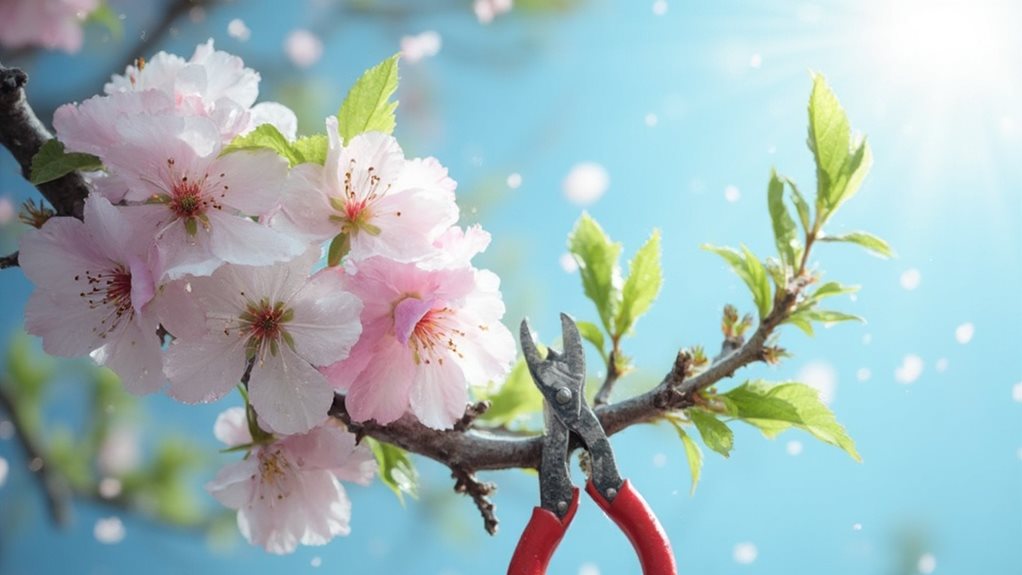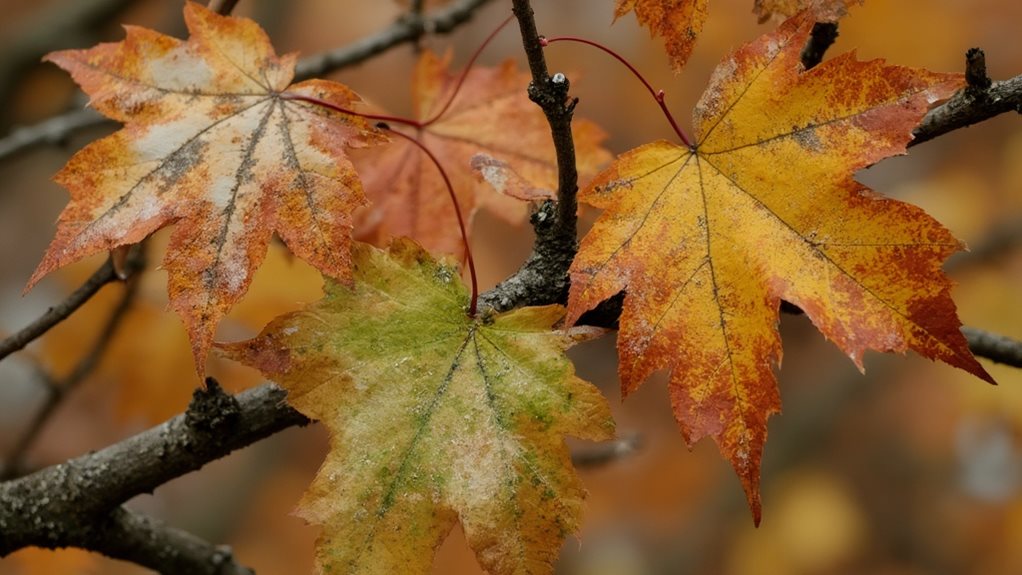
Seasonal Tree Care Tips
You’ll need to adapt your tree care routine throughout the seasons for best health. In spring, focus on pruning and checking winter damage. Summer requires adequate watering and protection from heat stress. Fall is ideal for preventive pruning and cleanup, while winter demands protection against harsh elements. Don’t forget regular inspections for pests and diseases. Understanding the specific needs of each season will help your trees thrive year-round.
Expert Highlights
- Spring pruning removes dead branches and winter damage while preparing trees for new growth and healthy development.
- Deep watering during summer encourages stronger root systems and helps trees withstand intense heat stress.
- Fall maintenance focuses on removing weak branches before winter to prevent damage from ice and snow loads.
- Winter protection includes wrapping young trees and maintaining proper mulch layers to guard against harsh conditions.
- Regular seasonal inspections help identify and address pest infestations, diseases, and environmental stressors throughout the year.
Spring Tree Care Essentials

As winter’s chill fades away, your trees need special attention to thrive in the upcoming growing season. Start by removing dead, diseased, or damaged branches before new growth begins.
You’ll want to inspect for winter damage and prune appropriately to encourage healthy spring development.
Now’s the perfect time to mulch around your trees, keeping the material 2-3 inches away from the trunk to prevent rot.
Spread mulch around trees in early spring, maintaining a safe distance from the trunk to ensure healthy growth and protection.
Apply a slow-release fertilizer if soil tests indicate deficiencies, and guarantee proper watering as roots become active.
Check for signs of pest infestations or diseases that may have overwintered, and treat them promptly.
Remove any competing vegetation and weeds from the base of your trees to reduce resource competition.
Remember to stake newly planted trees that might need support during spring storms.
Summer Tree Maintenance Guide
You’ll want to protect your trees from intense summer heat by providing adequate water and applying a layer of mulch around the base.
When it comes to summer pruning, focus on removing dead, diseased, or damaged branches to promote healthy growth and air circulation.
It’s best to prune during dry weather conditions to prevent the spread of disease and guarantee proper healing of cut surfaces.
Preventing Summer Heat Stress
While scorching summer temperatures can take a toll on your trees, implementing proper maintenance strategies will help them thrive during heat waves. You’ll need to water deeply and less frequently, encouraging roots to grow deeper into cooler soil.
Apply a 3-inch layer of organic mulch around the tree’s base, keeping it away from the trunk to prevent rot.
Monitor your trees for signs of heat stress, including wilting, yellowing leaves, and premature leaf drop. You can reduce stress by avoiding pruning during intense heat and providing temporary shade for younger trees.
If you’ve got newly planted specimens, they’ll need extra attention – water them twice weekly and consider using protective tree wraps to prevent sunscald on tender bark.
Proper Summer Pruning Techniques
Since summer pruning requires careful timing and technique, it is essential to focus on removing dead, diseased, or damaged branches first. You’ll want to prune during dry weather to prevent the spread of disease and guarantee proper healing. Make clean cuts at a 45-degree angle just above the branch collar.
| Pruning Task | Timing |
|---|---|
| Dead branches | Anytime |
| Water sprouts | Early summer |
| Crossing branches | Mid-summer |
| Shape maintenance | Late summer |
When pruning young trees, don’t remove more than 25% of the live branches in one season. For mature trees, limit pruning to no more than 10%. Remember to sanitize your tools between cuts, especially when removing diseased branches, to prevent spreading infections to healthy parts of the tree.
Fall Preparation and Pruning

You’ll want to start pruning your trees before winter arrives to prevent damage from ice and snow accumulation on weak branches.
It’s crucial to remove dead or diseased branches during fall when they’re easier to identify and before they become hazardous in harsh weather.
Your careful attention to pruning now will protect your trees through the winter months and promote healthy spring growth.
Prune Before Winter Hits
Fall pruning serves as a critical step in preparing trees for the harsh winter months ahead. You’ll want to remove dead, diseased, or damaged branches before winter storms cause them to break and potentially harm people or property.
Remember to complete your pruning tasks while temperatures remain above freezing to promote proper healing.
Key pruning priorities:
- Focus on removing crossed branches that rub against each other, as these can create wounds and entry points for disease.
- Cut back branches that extend over structures, walkways, or power lines to prevent winter snow and ice damage.
- Trim away water sprouts and suckers that drain energy from the tree’s main structure.
Use clean, sharp tools and make your cuts at 45-degree angles to prevent moisture collection and encourage healthy spring growth.
Remove Dead Branches Now
Remove dead branches immediately to protect your trees from potential winter hazards and disease. Look for branches that show no signs of life, such as lack of bark, absence of buds, or brittle wood. These lifeless limbs can become dangerous projectiles during winter storms and serve as entry points for harmful pathogens.
You’ll need sharp pruning shears, a pruning saw, and safety gear to complete this task effectively. Make clean cuts at the branch collar—the swollen area where the branch connects to the trunk or larger limb. Don’t leave stubs behind, as they’ll prevent proper healing.
For branches higher than arm’s reach, consider hiring a certified arborist to guarantee safety and proper technique. Remember to sanitize your tools between cuts to prevent spreading diseases.
Winter Protection Strategies
While cold temperatures pose significant risks to trees, implementing proper winter protection strategies helps safeguard your landscape investment.
You’ll want to focus on key protective measures before the first frost arrives to guarantee your trees survive the harsh winter months.
Consider these essential winter protection strategies for your trees:
- Wrap young trees with burlap or tree wrap to prevent sunscald and protect against hungry wildlife that might damage the bark.
- Apply a 3-4 inch layer of mulch around the base, keeping it away from the trunk, to insulate roots and retain moisture.
- Install wind barriers using stakes and burlap screens to shield vulnerable trees from harsh winter winds and ice damage.
Remember to monitor your trees throughout winter, especially after storms, to address any damage promptly.
Common Tree Problems by Season

In addition to protecting trees from winter damage, you’ll need to watch for specific problems that emerge during each season.
Spring often brings fungal diseases and pest infestations as trees wake from dormancy. Look for powdery mildew, leaf spots, and early signs of insect activity.
Summer’s heat and drought can stress trees, leading to leaf scorch, premature leaf drop, and increased vulnerability to borers.
You’ll also need to monitor for Japanese beetles and other leaf-feeding insects.
Fall introduces anthracnose in many species, while early frost can damage late-growing branches.
Watch for signs of root rot, especially in areas with poor drainage.
Winter’s main threats include bark splitting from freeze-thaw cycles, snow load damage, and winter burn on evergreens.
Salt damage near roadways can also harm roots and branches.
Professional Tree Services and When to Call
Professional arborists provide specialized expertise that goes beyond basic tree maintenance. You’ll want to contact these experts when facing complex situations that require technical knowledge, specialized equipment, or pose safety risks.
Call a certified arborist when you notice:
- Large dead branches, storm damage, or trees leaning precariously near structures
- Signs of serious disease or pest infestation that’s spreading rapidly
- The need for precise pruning of mature trees or removal of trees in confined spaces
While regular maintenance like basic pruning and mulching can be handled independently, don’t hesitate to seek professional help for challenging situations.
Licensed arborists carry proper insurance, follow industry safety standards, and understand local regulations.
Frequently Asked Questions
How Much Does a Fully Grown Tree Increase Property Value?
You’ll find that mature trees can boost your property value by 7-19%. For a $300,000 home, that’s an increase of $21,000-$57,000, making trees valuable landscaping investments.
Can I Transplant Mature Trees Between Seasons Safely?
You’ll have better success transplanting mature trees during dormancy (late fall or early spring) when they’re less stressed. Always hire professionals for large trees to guarantee proper root protection.
What Trees Are Best for Creating Natural Privacy Barriers?
You’ll get excellent privacy with evergreens like Leyland Cypress, Thuja Green Giant, or Italian Cypress. They grow quickly, stay dense year-round, and can reach heights perfect for screening.
How Deep Should Tree Roots Be for Optimal Growth?
You’ll want your tree roots to extend 2-3 feet deep, though most active roots grow in the top 12-18 inches of soil for better nutrient absorption and stability.
Which Tree Species Attract the Most Beneficial Wildlife to My Yard?
You’ll attract diverse wildlife by planting oak, cherry, birch, or maple trees. These species provide food and shelter for birds, butterflies, and small mammals throughout different seasons.
Expert Final Thougts
You’ll get the most from your trees by following these seasonal care guidelines and staying alert to potential issues throughout the year. Don’t hesitate to call a certified arborist when you’re unsure about proper maintenance or spot concerning symptoms. With regular attention and timely professional help, you can keep your trees healthy, strong, and beautiful across every season.
